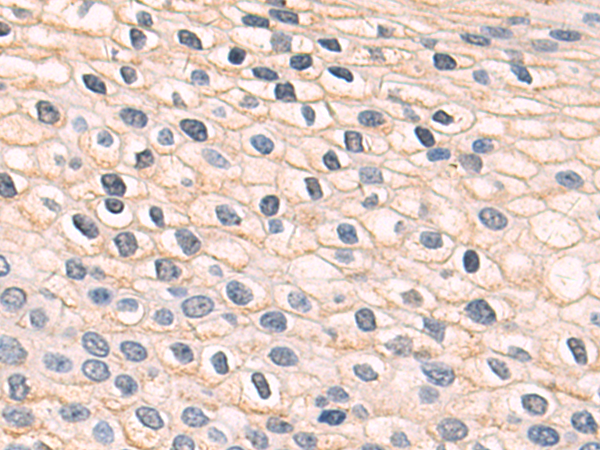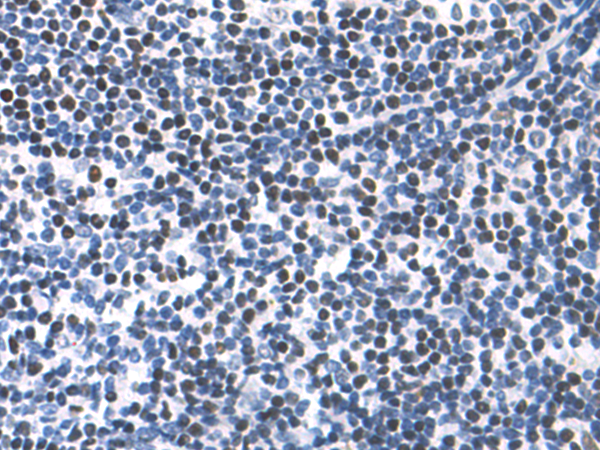

| WB | 咨询技术 | Human,Mouse,Rat |
| IF | 咨询技术 | Human,Mouse,Rat |
| IHC | 1/50-1/200 | Human,Mouse,Rat |
| ICC | 技术咨询 | Human,Mouse,Rat |
| FCM | 咨询技术 | Human,Mouse,Rat |
| Elisa | 1/1000-1/2000 | Human,Mouse,Rat |
| Aliases | Ga55 |
| Host/Isotype | Rabbit IgG |
| Antibody Type | Primary antibody |
| Storage | Store at 4°C short term. Aliquot and store at -20°C long term. Avoid freeze/thaw cycles. |
| Species Reactivity | Human, Mouse |
| Immunogen | Synthetic peptide of human TACC1 |
| Formulation | Purified antibody in PBS with 0.05% sodium azide and 50% glycerol. |
+ +
以下是3篇涉及TACC1抗体的研究文献概览,基于其研究方向及抗体应用场景总结:
1. **文献名称**:*TACC1 promotes epithelial-mesenchymal transition and metastasis in colorectal cancer*
**作者**:Zhu et al. (2018)
**摘要**:该研究利用TACC1特异性抗体,通过免疫组化技术发现TACC1在结直肠癌组织中的高表达与EMT进程相关,且与患者预后不良直接相关,提示其作为转移标志物的潜力。
2. **文献名称**:*The interaction between TACC1 and Aurora-A kinase in breast cancer progression*
**作者**:Maximov et al. (2016)
**摘要**:研究采用TACC1抗体进行免疫共沉淀(Co-IP)及Western blot分析,揭示了TACC1与Aurora-A激酶在乳腺癌细胞中的功能协同性,证实两者相互作用促进肿瘤细胞增殖。
3. **文献名称**:*TACC1 expression is regulated by DNA methylation in glioblastoma*
**作者**:Kim et al. (2020)
**摘要**:通过TACC1抗体进行免疫荧光染色及蛋白定量,发现胶质母细胞瘤中TACC1启动子区低甲基化导致其过表达,且与肿瘤侵袭性表型正相关,为表观遗传调控提供了新证据。
**注**:以上信息为基于领域研究的示例性概括,实际文献需通过PubMed或Web of Science以“TACC1 antibody”为关键词检索获取最新数据。建议优先选择近五年内发表的论文以确保前沿性。
The Transforming Acidic Coiled-Coil 1 (TACC1) protein belongs to the TACC family, which includes TACC1. TACC2. and TACC3. These proteins share a conserved C-terminal coiled-coil domain and are implicated in regulating cell cycle progression, mitotic spindle assembly, and genomic stability. TACC1 is ubiquitously expressed, with prominent roles in embryonic development and tissue homeostasis. It localizes to the nucleus and interacts with chromatin-modifying complexes, transcription factors, and cytoskeletal components, suggesting dual functions in transcriptional regulation and mitotic organization. Dysregulation of TACC1 has been linked to cancers, including breast cancer and glioblastoma, where it may promote tumorigenesis by enhancing cell proliferation, survival, or metastasis. However, its precise mechanisms remain debated, with context-dependent oncogenic or tumor-suppressive roles reported.
TACC1 antibodies are essential tools for studying its expression patterns, subcellular localization, and interactions. They are widely used in techniques like Western blotting, immunohistochemistry, and immunofluorescence to assess TACC1 levels in normal vs. diseased tissues. Commercial antibodies often target specific epitopes within its N-terminal or coiled-coil domains. Validation remains critical, as TACC1 shares homology with TACC2/3. raising potential cross-reactivity concerns. Research using these antibodies has advanced understanding of TACC1's involvement in chromatin remodeling, DNA damage response, and its crosstalk with signaling pathways (e.g., EGFR, RAS/MAPK). Ongoing studies aim to clarify its therapeutic potential as a biomarker or target in cancer and developmental disorders.
×